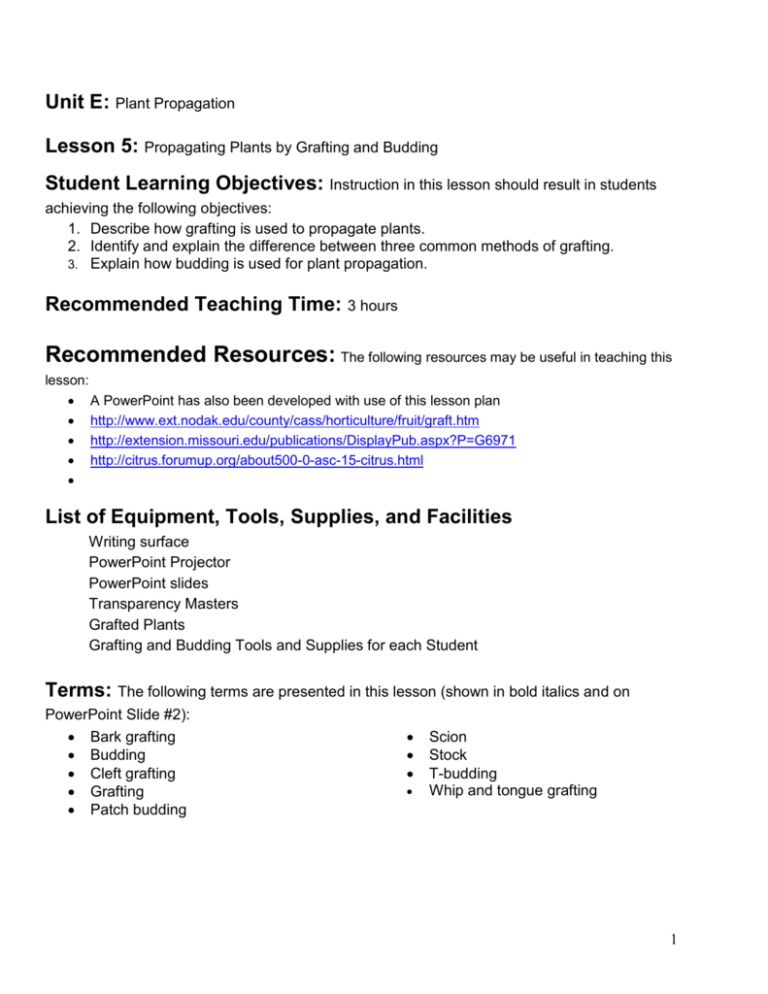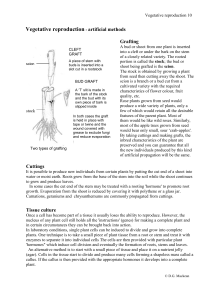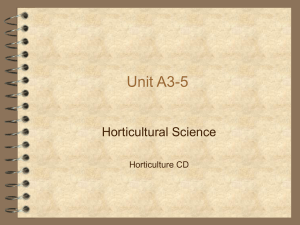Propagation by Grafting and Budding
advertisement

Unit E: Plant Propagation Lesson 5: Propagating Plants by Grafting and Budding Student Learning Objectives: Instruction in this lesson should result in students achieving the following objectives: 1. Describe how grafting is used to propagate plants. 2. Identify and explain the difference between three common methods of grafting. 3. Explain how budding is used for plant propagation. Recommended Teaching Time: 3 hours Recommended Resources: The following resources may be useful in teaching this lesson: A PowerPoint has also been developed with use of this lesson plan http://www.ext.nodak.edu/county/cass/horticulture/fruit/graft.htm http://extension.missouri.edu/publications/DisplayPub.aspx?P=G6971 http://citrus.forumup.org/about500-0-asc-15-citrus.html List of Equipment, Tools, Supplies, and Facilities Writing surface PowerPoint Projector PowerPoint slides Transparency Masters Grafted Plants Grafting and Budding Tools and Supplies for each Student Terms: The following terms are presented in this lesson (shown in bold italics and on PowerPoint Slide #2): Bark grafting Budding Cleft grafting Grafting Patch budding Scion Stock T-budding Whip and tongue grafting 1 Interest Approach: Use an interest approach that will prepare the students for the lesson. Teachers often develop approaches for their unique class and student situations. A possible approach is included here. Bring in apples, or a young apple tree seedling, and pictures of mature apple trees or apple trees in an orchard. Ask students to discuss how long it would take to grow an apple producing orchard if the trees were planted from seed. Introduce grafting as a technique that can greatly speed the propagation process by uniting the stem portion (scion) to the existing root portion (stock) of another similar plant. You may also discuss the fact that apple trees grown from seed rarely produce good fruit and that grafting transplants a good variety of a fruit tree onto the rootstock of perhaps a poor fruit bearing variety of the tree. ** Use this activity to lead into how grafting is done. Summary of Content and Teaching Strategies Objective 1: Describe how grafting is used to propagate plants. (PowerPoint Slide #3) I. Grafting is the process of connecting two plant parts (a stem and a root) together in such a way that they will unite and continue to grow as one plant. A. Plants are grafted to create new plants, to create dwarf plants because some roots have a dwarfing effect on the stem, to increase the hardiness of a plant, to increase disease resistance in a plant, or to change the natural form of a plant. (PowerPoint Slide #4) B. A grafted plant consists of the scion, which is a short piece of stem with two or more buds, and the stock (sometimes referred to understock or rootstock) which is the lower portion (root or growing plant) of the graft. C. There must be contact of the cambium layer of the scion and the cambium layer of the stock for successful growth of the graft. (PowerPoint Slide #5) It is also essential that the graft be kept moist. Drying out of the graft is prevented by covering the grafted area with wax, grafting compound, rubber or polyethylene banding. It is also important that the scion and stock are compatible plants (of the same genus) i.e. apple to apple, and that the grafting is done at the proper time of the year. **If possible show students a small fruit tree or rose bush that has been propagated by grafting. Show students the standard tools (knife, grafting wax, rubber banding etc.) that are used by propagators when grafting. PowerPoint Slide #6 shows some of these tools. Objective 2: Identify and explain the difference between three common methods of grafting. 2 (PowerPoint Slide #7) II. The main reason for grafting is to asexually propagate plants that are difficult by other methods. Grafting is often used in the production of orchard trees, shade trees, and roses. There are several grafting methods commonly used by propagators. (PowerPoint Slide #8) A. Whip and tongue grafting is commonly used to propagate fruit trees especially apple and pear. The root of a young seedling tree is used for the rootstock. The scion is a dormant twig containing three or four buds. It is about the diameter of a pencil. (PowerPoint Slide #9) The stock and the scion are cut at a slant angle. The whip or tongue is then made by making a single cut 1 centimeter deep into the sloping cut. Both the scion and rootstock have a tongue cut. Insert the scion tongue cut into the rootstock tongue cut. Line up the cambium layers of both cuts and bind the graft with tape. Seal the graft with wax or grafting compound to prevent moisture loss. (PowerPoint Slide #10 shows an illustration of whip and tongue grafting. PowerPoint Slides #11, #12, and #13 shows a real example of whip and tongue grafting.) (PowerPoint Slide #14) B. Cleft grafting is often used to join a smaller scion to a larger stock part. Cleft grafting is usually done in late winter to top graft new cultivars on to existing tree limbs or rootstocks. The branch or tree is cut straight across. With a knife or grafting tool, a split or slit is made in the cut end of the limb or rootstock. Next, a scion piece 7 to 12 centimeters long with one or two buds is cut and the end sharpened into a thin wedge. (PowerPoint Slide #15) Slide the edge into the split end of the rootstock, matching the cambium layers of the scion and the rootstock. Cover the graft with tape and seal to prevent moisture loss. (PowerPoint Slides #16, #17, and #18 shows a real example of cleft grafting.) (PowerPoint Slide #19) C. Bark grafting is similar to cleft grafting in that the grafts join smaller scion wood to larger rootstock. This method is done in the early spring when the bark easily separates from the wood along the cambium layer. Bark grafting is used to propagate fruit, ornamental, and shade trees. (PowerPoint Slide #20) The top from a 1 to 5 centimeters diameter rootstock tree is cut. On one side of the cut, a 5 centimeter long cut down through the bark of the rootstock is made. A scion is selected and the bottom end is shaped to be slanted on one side to a sharp point. The bark is pulled from the rootstock slightly along the slit cut and the sharpened part of the scion is slid in between the bark and the wood, carefully matching the cambium layers of the scion and the rootstock. One or two small nails are then driven through the bark on each side of the slit, or the graft is wrapped with twine to hold it tight. The graft area is sealed with wax or grafting compound to prevent moisture loss. (PowerPoint Slide #21 shows an illustration of bark grafting. PowerPoint Slide #22, #23, #24, #25, #26, #27, and # 28 shows a real example of bark grafting. ) **Use TM: E5-1 to illustrate whip-and-tongue and cleft grafting. Collect branches that grew the preceding year for scions. They may be collected anytime the wood is dormant and may be stored in the refrigerator or a very cool area for a week in a plastic bag. If 3 available attain rootstock for students to use to learn the whip-and-tongue method of grafting. Use TM: E5-2 to illustrate the steps involved in making a bark graft. Objective 3: Explain how budding is used for plant propagation. (PowerPoint Slide #29) III. Budding is similar to grafting except that the scion is reduced to a single bud with a small portion of bark or wood attached. The single bud scion is joined with the rootstock to form a new plant. Budding is done in the spring or fall when the bark separates easily from the wood of the rootstock. Budding is faster, easier, and more economical than grafting. No wax is necessary, and the cambium layers need not be aligned. Also, less scion wood is used. Most roses and fruit trees are propagated by budding. (PowerPoint Slide #30) A. T-budding involves taking buds from one plant and inserting them under the bark of the rootstock. Cut a T shape through the bark of the rootstock tree. Open the flaps of the side of the T. Collect a bud from a budwood stick by inserting the knife at the base of the bud and carefully cutting out the bud including a small sliver of wood. (PowerPoint Slide #31) Make a horizontal cut just above the bud to sever it and the sliver of wood from the budwood stick. Insert the bud, right side up, into the opening of the T cut. Slide it tightly into the cut and secure it with a rubber budding strip. Wrap the rubber budding strip above and below the bud, stretching the budding strip to make a tight wrap that will prevent loss of moisture from the bud. (PowerPoint Slide #32 shows an illustration of T-budding. PowerPoint Slide #33, #34, and #35 shows an example of T-budding.) (PowerPoint Slide #36) B. Patch budding is used when the plant’s bark is thick, such as on pecans and walnuts. This method of budding is done before growth starts in the spring. The bud patch must be precisely matched with the patch opening in the bark on the rootstock. (PowerPoint Slide #37) Special budding knives are used to make the cuts on both the budstick and the rootstock. The area, except for the bud, is then covered with grafting wax or waxed cloth to hold the bud in place and prevent the loss of moisture. (PowerPoint Slide #38 shows an illustration of patch budding. PowerPoint Slide #39 and #40 shows an example of patch budding. ) **Use TM: E5-3 to demonstrate the differences between T-budding and patch budding. Collect scion materials during the winter when the wood is dormant. If available attain rootstock for students to use to practice T-budding. Review/Summary: Use the student learning objectives to summarize the lesson. Have the students explain the response to the anticipated problem of each objective. Student responses can be used to determine which objectives need to be reviewed. Questions on PowerPoint Slides #41 and #42 can also be used as review. 4 Application: Application may involve the following student activity. Students may collect scion material, perform grafting, and care for the newly grafted plants. Evaluation: Evaluation should focus on student achievement of this lesson’s objectives. A sample written test is attached. Answers to Sample Test: Part One: Matching 1. d 2. g 3. b 4. i 5. f 6. a 7. c 8. e 9. h Part Two: Completion 1. whip-and-tongue, cleft, bark 2. water or moisture 3. stock 4. scion 5. T-budding, patch budding Part Three: Short Answer 1. To asexually propagate plants that are difficult to propagate by other methods. 2. a. The scion and stock must be compatible, such as grafting an apple onto an apple. b. The cambium of the scion must be in close contact with the cambium of the stock. c. Grafting must be done at the correct time of the year. d. All cut surfaces must be immediately covered with grafting compound, wax etc. to prevent the surfaces from drying out. 3. Budding is the joining of a single bud scion with the rootstock of another plant. It is done mainly to asexually propagate plants that are difficult to propagate by other methods. 4. The scion is reduced to a single bud with a small portion of bark or wood attached. 5 Sample Test Name_____________________________________ Test Unit E Lesson 5: Propagating Plants by Grafting and Budding Part One: Matching Instructions. Match the term with the correct response. Write the letter of the term by the definition. a. bark grafting d. grafting g. scion b. stock e. T-budding h. patch budding c. budding f. cleft grafting i.whip-and-tongue grafting _______ 1. The process of connecting two plant parts to grow as one plant. _______ 2. A short piece of stem with two or more buds used in grafting. _______ 3. The lower root portion of a plant used in grafting. _______ 4. Both the scion and stock have a slit cut that helps to hold them firmly together when grafting. _______ 5. A method for joining a smaller scion to a larger stock part. _______ 6. A more difficult method of grafting in which the scion is inserted between the bark and the wood of the rootstock. _______ 7. Similar to grafting, but only a single bud is selected from the scion to insert into the rootstock. _______ 8. The bud from one plant is inserted into a T shape cut through the bark of the rootstock tree. _______ 9. A method of propagation used when the plant’s bark is thick, such as on pecans and walnuts. Part Two: Completion Instructions. Provide the word or words to complete the following statements. 1. Three common types of grafting are ____________________, ______________________, and ________________________________. 2. Grafting compound or wax is used to prevent the loss of __________________. 3. The root or growing part of the plant used for grafting is the __________________. 6 4. The branch or stem portion used in plant grafting is known as the ______________. 5. Two common methods of budding are _________________________________ and ____________________________________. Part Three: Short Answer Instructions. Provide information to answer the following questions. 1. What is the main reason for grafting? 2. List four factors that help insure that graft unions are successful. 3. What is budding and why is it done? 4. How is budding different from grafting? 7 TM: E5-1 WHIP-AND-TONGUE GRAFT AND CLEFT GRAFT 8 TM: E5-2 MAKING A BARK GRAFT 9 TM: E5-3 T-BUDDING AND PATCH BUDDING 10








